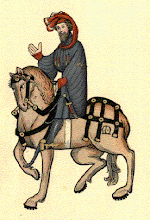Miscellaneous:
Mezza Volta di Mano: Literally, a half-turn of the hand. This is usually used to describe turning the hand from one guard to another with the most common application being when turning the sword from Coda Lunga Stretta to Porta di Ferro Stretta and viceversa. Another use, which is rather specialized, is to turn a true-edge cut into a false-edge cut.
Mezza Volta di Persona: This is the action of turning the body without stepping, but by only turning on the balls of your feet.
Riverso di Gamba Levata: Literally, Riverso of raised foot. This is a Riverso performed as you pass back, a defensive measure used to cover a retreat after an action. The preparation of the Riverso is nearly always made by turning it with your elbow to your inside, rather like a sabre Molinello. The raised foot refers to the fact that the timing of the cut means that the passing foot will still be in the air as the Riverso is made.
Riverso Spinto: Literally, pushed Riverso. A Riverso made such that pushing the hilt away from you instead of drawing it toward you makes the sawing component that every cut should have. The preparation for this cut is usually the same as that for the Riverso di Gamba Levata.
Riverso Spinto di Gamba Levata: A Riverso di Gamba Levata where the Riverso is a Riverso Spinto.
Pass: One foot passes from behind the other foot to in front of it, or vice versa. For example, from Coda Lunga Stretta, pass forward with your left foot and end in Coda Lunga Alta.
Step: One foot steps away from the other, either as an accrescimento (i.e. sort of a lunge) or from a position of both feet standing close together. For example, from Coda Lunga Alta, step forward with your left foot and attack with a Stoccata.
Gather: One foot is drawn close to the other. This can be the rear foot being drawn up to the front foot or vice versa.
Chasing Step: A step where the rear foot gathers forward and then the other foot steps forward. For example, from Coda Lunga Stretta, make a chasing step forward by gathering forward with your left foot and then stepping forward with your right foot. The distance covered is about equal to a Pass.
Circular Step: Often, after stepping or passing offline, the rear foot will circle around behind the front foot to orient to the new line of direction; pivoting on the front foot does this. This will typically be written as: ...the left foot circling behind the right.
Great Pass: A Pass, which ends in a larger step than usual, so that, the feet are nearly as far apart as they would be after performing an accrescimento.
Note that many steps are oblique or off of the imaginary line running from you to your opponent. The direction is always given in relation to the opponent. For example, if you are in Porta di Ferro Stretta, you might pass with your left foot to your opponent‘s right and end in Cinghiara Porta di Ferro Stretta. Additionally, there are oblique steps where you appear to cross one of your feet in front of the other. In this case, you must be sure to turn your hips to remain stable. For example, from Coda Lunga Stretta, you might step with your right foot to your opponent‘s right to parry a blow in Guardia di Faccia. Be sure that when you do this, you turn your hips to your left rather than just stepping across your rear foot. In this way, you will have turned your entire body somewhat to your left, which will align your body to receive the force of the blow.
Finally the figures are shown with bucklers and not the rotella, this should be a minor detail as the guard is what is being described.
Monday, 1 February 2010
Subscribe to:
Post Comments (Atom)

No comments:
Post a Comment